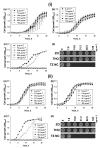Bioconjugated Thymol-Zinc Oxide Nanocomposite as a Selective and Biocompatible Antibacterial Agent against Staphylococcus Species
- PMID: 35743214
- PMCID: PMC9224476
- DOI: 10.3390/ijms23126770
Bioconjugated Thymol-Zinc Oxide Nanocomposite as a Selective and Biocompatible Antibacterial Agent against Staphylococcus Species
Abstract
Owing to the rapid spread of antibiotic resistance among Staphylococcus species, effective and low-risk alternatives to antibiotics are being actively searched. Thymol (THO), the most abundant component of the oil extracted from thyme, can be considered as a natural antibacterial alternative. However, the low antibacterial activity and non-selectivity of THO limit its usage as a universal anti-Staphylococcus agent. Herein, we report the bioconjugation of THO with ZnO nanoparticle (ZO), which resulted in the TZ nanocomposite (NC), as a potent and selective antibacterial agent against Staphylococcus species, particularly S. epidermidis. The cell-free supernatant (CFS) of ATCC 25923 cultures was employed for the production of TZ NC. Successful production of TZ NC was confirmed via X-ray diffraction (XRD), Fourier-transform infrared (FT-IR) spectroscopy, and ultraviolet-visible (UV-Vis) studies. TZ NC had selective efficacy against Staphylococcus species, with MIC values 2-32-fold lower than THO. The antibacterial mechanisms of TZ NC are proposed to involve membrane rupture, suppression of biofilm formation, and modulation of new cell wall and protein-synthesis-associated cellular pathways. Its biocompatibility against HCT116 cells was also checked. Our findings suggest that the TZ nanocomposite could improve the selectivity and bactericidal activity of THO against target species.
Keywords: Staphylococcus; antimicrobial; biocompatibility; selectivity; thymol.
Conflict of interest statement
The authors declare that they have no known competing financial interest or personal relationships that could have appeared to influence the work reported in this paper.
Figures






References
-
- Mukherjee R., Priyadarshini A., Pandey R.P., Raj V.S. Antimicrobial Resistance in Staphylococcus aureus. In: Aqib A., editor. Insights into Drug Resistance in Staphylococcus aureus. IntechOpen; London, UK: 2021. - DOI
MeSH terms
Substances
Grants and funding
LinkOut - more resources
Full Text Sources

